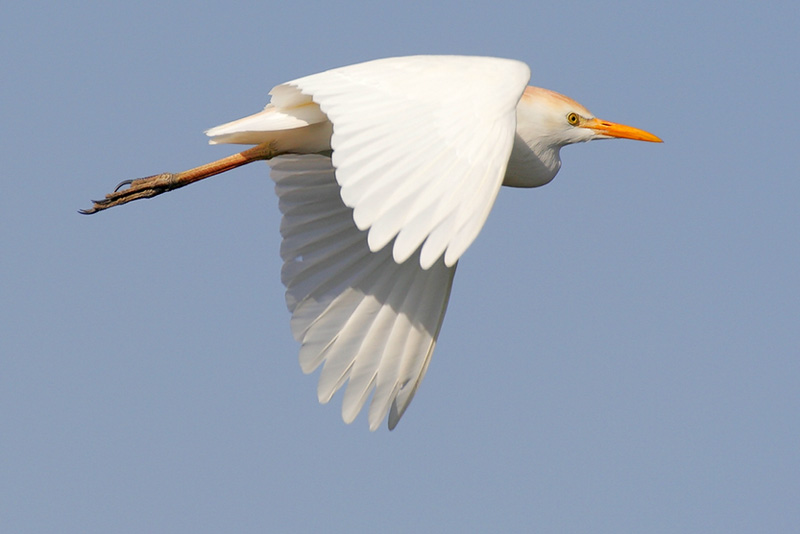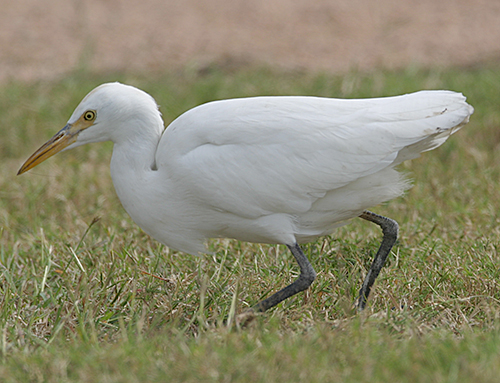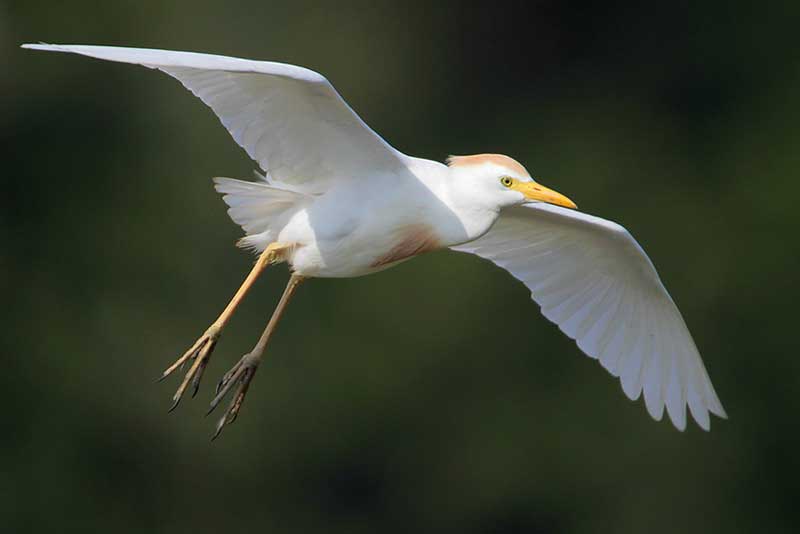Unusual among herons, the Cattle Egret is an upland species often found in association with livestock. Native to Africa, the Cattle Egret’s strong dispersal tendencies and its adaptability have led to its spread and population increases throughout much of North America.
Cattle Egrets and other herons are colonial nesters and frequently lay eggs in nests of other species. Such eggs have limited hatchability, because they are often laid too late in the incubation cycle to survive.
On this page
Description of the Cattle Egret
BREEDING MALE
The Cattle Egret is a small, white heron with a rather short neck, dark legs, and a yellow bill.
Yellowish plumes on back may also be present. Length: 20 in. Wingspan: 36 in.

Photograph © Greg Lavaty.
Female
Sexes similar.
Seasonal change in appearance
During the breeding season, orange patches appear on the head, breast, and back, and the legs become orange.
Juvenile
Similar to adults, but with a blackish bill.
Habitat
Cattle egrets are found in farms, pastures, and marshes. They are more terrestrial than other herons, and often associate with cattle.
Diet
Primarily large insects disturbed by grazing cattle, but also crayfish, worms, and snakes.

Photograph © Sam Crowe.
Behavior
Cattle Egrets follow cattle or even tractors, waiting for grasshoppers and other large insects to move.
Range
Cattle Egrets occur in summer over much of the United States. They are native to Africa, but in a dramatic range expansion spread to South America and moved northward to occupy much of the U.S. Their population here is now stable to increasing.
More information:
Bent Life History
Visit the Bent Life History for extensive additional information on the Cattle Egret.
Wing Shape
The shape of a bird’s wing is often an indication of its habits and behavior. Fast flying birds have long, pointed wings. Soaring birds have long, broad wings. Different songbirds will have a slightly different wing shape. Some species look so much alike (Empidonax flycatchers) that scientists sometimes use the length of specific feathers to confirm a species’ identification.
Wing images from the University of Puget Sound, Slater Museum of Natural History
Fun Facts
Cattle Egrets were first noted in South America around 1880, and within 100 years had expanded northward to occupy much of the U.S.
Cattle Egrets do not breed until they are 2 or 3 years of age.
Vocalizations
Cattle Egrets give short croaks during the breeding season.
Similar Species
Juvenile Cattle Egrets with black bills may resemble Snowy or Reddish Egrets, but have shorter necks. Other herons and egrets are usually seen in water, while Cattle Egrets are usually found in pastures or fields.
Related: Egret vs Heron
Juvenile Little Blue Heron
The juvenile Little Blue Heron is also similar, but has greenish instead of blackish legs.
Great Egret
The Great Egret is larger, with longer neck. Typically found near water.
Snowy Egret
The all white Snowy Egret has a thin, black bill and yellow feet.
Nesting
The nest is a shallow platform of twigs and reeds, usually placed 6-13 feet high in a tree or shrub. Cattle Egrets nest colonially with other herons.
Number: Usually lay 3-4 eggs.
Color: Pale blue.
Incubation and fledging:
The young hatch at about 23-24 days and leave the nest in another 20 days, though continuing to associate with the adults for some time.
Bent Life History of the Cattle Egret
The Cattle Egret was not established in the United States at the time the Bent Life History series for egrets and herons was written.
Cattle Egrets were introduced into South America from Africa, and have steadily expanded northward and into the United States.


